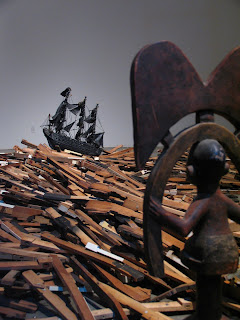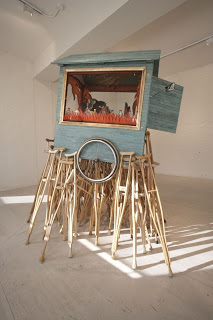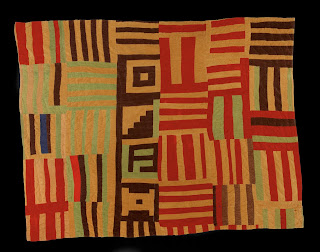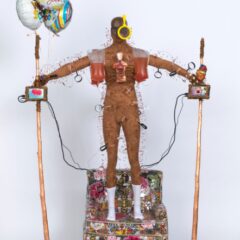
Radcliffe Bailey Storm at Sea (2006), piano keys, African sculpture, model boat, paper, acrylic, glitter, and gold leaf 212 x 213 inches Courtesy of the artist and Jack Shainman Gallery, New York © Radcliffe Bailey
I went out to P.S.1 Friday to see Neohoodoo: art for a forgotten faith, co-organized with the Menil Collection, Houston. According to the press release the exhibition challenges conceptions of insider and outsider art, as a number of the artists from North, Central and South America incorporated vernacular religious forms and practices in works that address contemporary ritual and spirituality. Vernacular expressions of faith were much in evidence on the subway ride to Queens: in a tunnel below Port Authority a man had laid out dozens of religious placards (largely warnings; his is an angry God) and used a bullhorn to encourage passers-by to contemplate the afterlife. On my train another man invoked His name as he asked for spare change.

It was hard to tell just how genuine the belief was behind much of the work at P.S. 1, although there was lots of social commentary. Betye Saar was represented by a wonderful piece from 1972: Gris-Gris Box, a small wall shrine with a box containing a black figure surrounded by eyes, with what looked like dreadlocks hanging beneath. The piece certainly commemorated a history of African spirituality within African American culture. And Pepón Ossorio’s Lonely Soul, his version of a portable shrine made from a piragua (cart for selling snow-cones) containing figures in flames and supported by crutches, was respectful of syncretic religious practice even in its exaggerations.

Jimmie Durham Anti-Brancusi(2005) cardboard, wood, serpentine stone, text panel on paper, 48 x 27 x 31 1/8 in.
But one of my favorite pieces was certainly an ironic commentary on secular modernism’s displacement of worship onto art. Anti-Brancusi (2005) by Jimmie Durham presented a piece of serpentine stone that the artist found in the river Po on a pedestal of boxes (two for shoes and one for a urinal; yes, we get the reference). Another wonderfully-ironic work was Sanford Biggers’ Ghetto Bird Tunic (full length) (2006), a bubble jacket entirely covered with feathers from tropical birds. Surely he was using this take-off on a shaman’s costume to reference the flamboyance of masculine ghetto display and its masquerade of power. David Hammons’ Untitled (1989), a circle of glass bottles standing upright was exhibited in a gallery with two other circular works; but while James Lee Byars’ huge halo of gilded brass might invoke spiritual infinitude, Hammons’ empty bottles of cheap wine more likely refer to an unending cycle of poverty and addiction.
This art contained far too many knowing winks to mistake it for anything but high art playing with the vernacular.
Alternative American Art Worlds at the PMA

James Castle Short Ribs soot on paper, 3 1/4 x 8 1/4 in., The James Castle Collection, L.P. courtesy of the J. Christ Gallery, Boise, Idaho.
I spent Saturday at a symposium at the Philadelphia Museum of Art (PMA) that coincided with three exhibitions of work beyond the mainstream cannon: quilts from Gee’s Bend, a retrospective of cardboard constructions, books and drawings by James Castle, and the first survey of Thomas Chambers, a 19th century painter of landscapes and marine paintings formerly characterized as folk art. The speakers emphasized the cultures surrounding the production of these artworks and the often practical considerations that affected questions of style. They also discussed the historiography of the works’ reception.
Katherine Foster, the PMA’s curator of American Art and Director of its Center for American Art, emphasized that Chambers and many artists characterized as folk were, in fact, professionals working for known clients and suggested that much of their style was a reflection of the patrons’ tastes and means. She quoted an advertisement by a portraitist who offered either likenesses in an academic style, three-dimensional and with shading, or for those who could not afford these he could work in the flat style (that we describe as folk). Bernard Herman, professor at the University of Delaware, discussed the quilts of Gee’s Bend in the words of their creators. In extensive conversations he had with the women they distinguished between their pretty quilts and ugly quilts, the distinction reflecting the amount of time they had to work on each.

Willie “Ma Willie” Abrams Roman Stripes variation (c. 1975), the Tinwood Alliance, Atlanta, photo by Pitkin Studio, Rockford IL.
Brendan Greaves, writer and folklorist, analyzed James Castle’s works that incorporate language and suggested that they reveal a true poetics, despite being self-generated. Paul D’Ambrosino, chief curator of the Fenimore Museum, Cooperstown,N.Y. discussed the significance of the Erie Canal, along which Thomas Chambers worked, in opening up trade and creating demand for crafts and art. The canal also made large area of land accessible which in turn stimulated the demand for landscape paintings such as Chambers’. Linda Eaton, curator of textiles at Winterthur Museum charted the history of quilts being exhibited in American art museums and galleries; this began at the Newark Museum in 1919 and made a splash in the art world with an exhibition at the Whitney Museum of American Art in 1971. Quilts were the products of all classes and diverse traditions, she emphasized, and their history is hardly straightforward. John Ollman of Fleischer/Ollman Gallery, Philadelphia situated Castle’s work within a history of the discovery of self-trained American artists, emphasizing that mainstream artists were often the first to appreciate their work.









